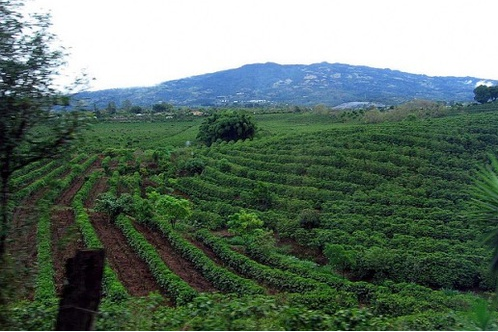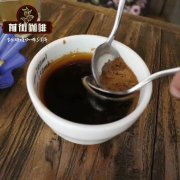What's the difference in the taste of coffee beans between sun-drying and washing?
The influence of coffee flavor, in addition to varieties, producing areas, planting methods, there is also an important process-coffee raw bean treatment. Different treatments will lead to different flavors of coffee beans. Generally speaking, it is common to hear that raw beans are treated by "sun exposure" and "washing". What is the difference between these two methods?.
Before we understand the method of raw bean treatment, we must first understand the structure of coffee fruit! The coffee fruit appears green at first, then it changes to red, yellow or orange according to the variety after ripening. It is also known as "coffee cherry" because it looks like a cherry.
Generally speaking, the roasted coffee beans on the market are actually the seeds inside the coffee fruit. usually there are two seeds (sometimes only one) in each coffee fruit. the outer-to-inner structure is exocarp, pulp, pectin layer, endocarp (seed shell), silver skin, seed, and the processing method of sun or water washing is to remove these external structures. To get the internal coffee seeds (coffee beans).
Sun drying is the oldest and most primitive treatment of coffee beans. Compared with water washing, this drying method of coffee is also known as "natural coffee" or "sun coffee". The harvested coffee fruit is directly exposed to the sun for about two to four weeks. This method is generally used in countries with a clear dry and wet climate.
The process of solarization treatment is very simple, does not require too many tools and equipment, and does not need to use water except for the steps of removing floating beans, so it is widely used in areas where water resources are not abundant and less affluent.
But using the sun method requires enough space exposure, and because the coffee beans must be placed outside, there are often fallen leaves, insects and other impurities mixed in. And the intensity of sunlight varies every day, so it is difficult to control the dryness of coffee beans. It takes more manpower to turn regularly in order to ensure that mildew and decay will not occur.

However, there is an improved design of "African viaduct". The weaving net with tripod can avoid moisture and soil impurities on the ground, and the air convection wind makes the coffee fruit more ventilated and drier.
The technology of washing was invented by the Dutch in the 18th century. Due to the frequent rain and high humidity in some countries, it is impossible to implement the solarization method at all, so although the process is relatively cumbersome, it is the most widely used treatment method at present. The biggest difference from the sun method is the use of fermentation to remove the pectin layer.
Water washing method is used to treat coffee beans with less impurities and more complete appearance, and because the pulp in the coffee fruit has been removed from the very beginning, there is no need to worry about mildew, and the overall quality is stable. However, the process of washing is complex and tedious, and requires a lot of water, so the cost is relatively higher than the sun method, and it is less used in areas where water resources are scarce.
In the past, the treatment of the sun was considered to be low-cost, unrefined, low-priced beans, often used for commercial grade coffee beans with complex taste, different quality (different water content), too many defective beans and other negative problems. however, in recent years, with the popularity of fine coffee and the manual grading of coffee, many sun beans have been internationally recognized as high-level high-quality beans. Sun beans have a sweet and sour taste of tropical fruits, leaving coffee beans naturally mellow, rich in flavor, and sometimes with a hint of wine! And washed beans due to the fermentation process is better controlled, so the flavor is not like sun beans have miscellaneous flavor, the front section of the fruit acid brightness, flower aroma performance is more obvious, the overall taste is refreshing!
Important Notice :
前街咖啡 FrontStreet Coffee has moved to new addredd:
FrontStreet Coffee Address: 315,Donghua East Road,GuangZhou
Tel:020 38364473
- Prev

The advantages and disadvantages of instant coffee How to brew a good instant coffee coffee powder What brand is good
Professional coffee knowledge exchange More coffee bean information Please pay attention to coffee workshop (Weixin Official Accounts cafe_style) Well, this question reminds me that 20 years ago, there was a habit of most people drinking coffee.(Maxwell or Nestle, creamer powder and vitamin sugar) This is a common coffee combination in the 1980s. What proportion will bubble out more smooth? this problem
- Next

Yemeni mocha
Yemen, the hometown of mocha coffee, is the first country in the world to produce coffee on a large scale as a crop. Yemeni mocha coffee has distinctive taste characteristics, special taste and varied levels. It has a strong sour taste, a pleasant fruit acidity, and an obvious chocolate flavor. The stronger the coffee is, the easier it is to taste the chocolate. So, now
Related
- Beginners will see the "Coffee pull flower" guide!
- What is the difference between ice blog purified milk and ordinary milk coffee?
- Why is the Philippines the largest producer of crops in Liberia?
- For coffee extraction, should the fine powder be retained?
- How does extracted espresso fill pressed powder? How much strength does it take to press the powder?
- How to make jasmine cold extract coffee? Is the jasmine + latte good?
- Will this little toy really make the coffee taste better? How does Lily Drip affect coffee extraction?
- Will the action of slapping the filter cup also affect coffee extraction?
- What's the difference between powder-to-water ratio and powder-to-liquid ratio?
- What is the Ethiopian local species? What does it have to do with Heirloom native species?

